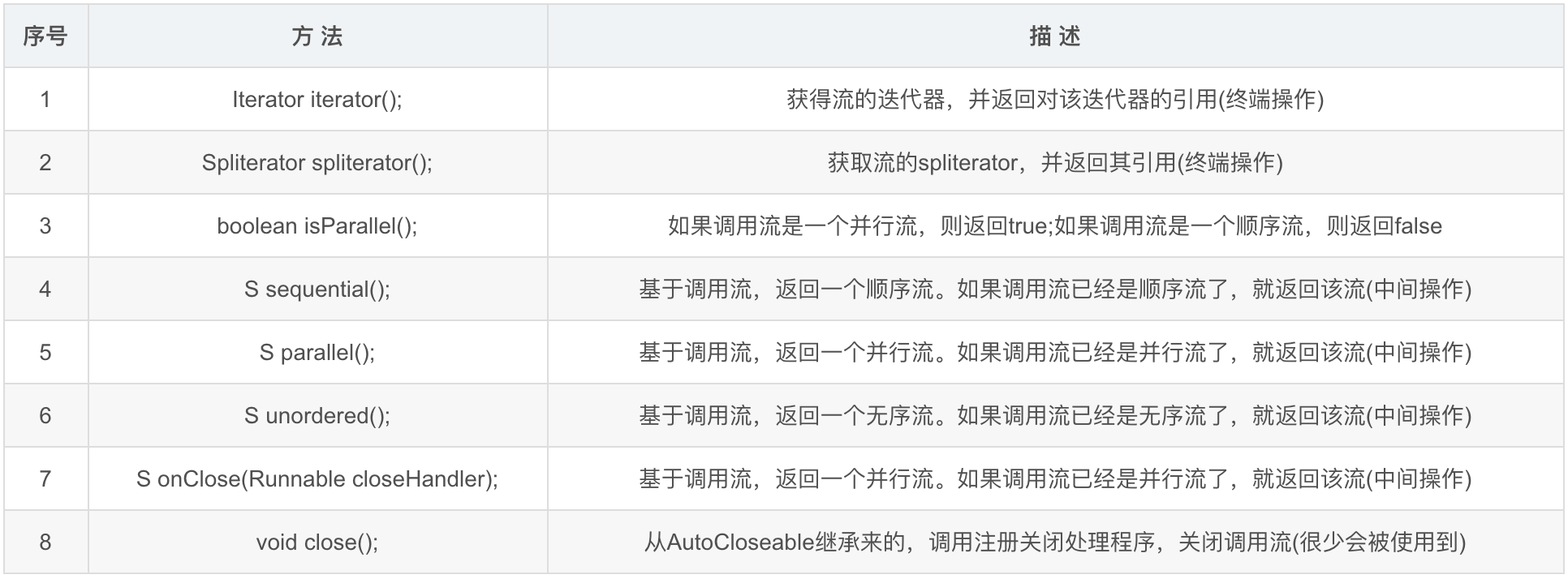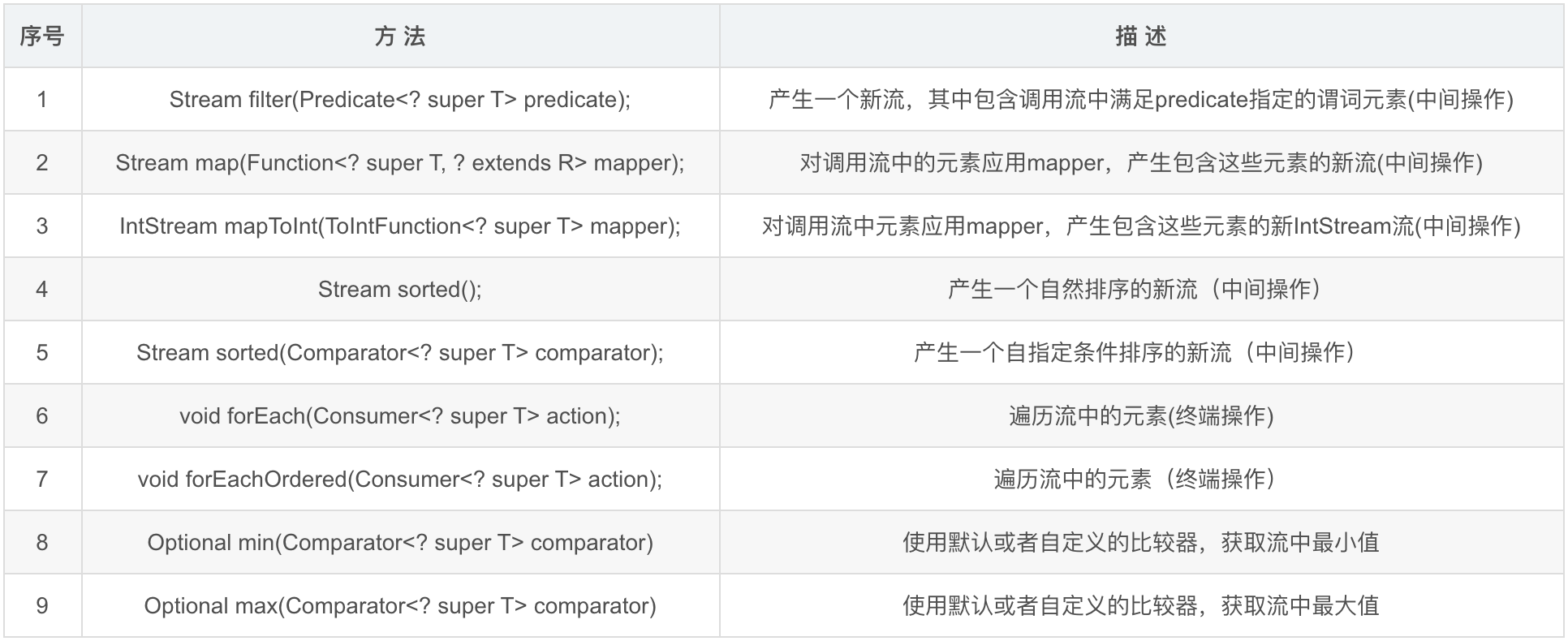一、概念普及
Java8新添加了一个特性:流Stream。Stream让开发者能够以一种声明的方式处理数据源(集合、数组等),它专注于对数据源进行各种高效的聚合操作(aggregate operation)和大批量数据操作 (bulk data operation)。
Stream API将处理的数据源看做一种Stream(流),Stream(流)在Pipeline(管道)中传输和运算,支持的运算包含筛选、排序、聚合等,当到达终点后便得到最终的处理结果。
二、特性概述
元素:Stream是一个来自数据源的元素队列,Stream本身并不存储元素。
数据源:(即Stream的来源)包含集合、数组、I/O channel、generator(发生器)等。
聚合操作:类似SQL中的filter、map、find、match、sorted等操作
管道运算:Stream在Pipeline中运算后返回Stream对象本身,这样多个操作串联成一个Pipeline,并形成fluent风格的代码。这种方式可以优化操作,如延迟执行(laziness)和短路( short-circuiting)。
内部迭代:不同于java8以前对集合的遍历方式(外部迭代),Stream API采用访问者模式(Visitor)实现了内部迭代。
并行运算:Stream API支持串行(stream() )或并行(parallelStream() )的两种操作方式。
注意:
1、stream不存储数据,而是按照特定的规则对数据进行计算,一般会输出结果;
2、stream不会改变数据源,通常情况下会产生一个新的集合;
3、stream具有延迟执行特性,只有调用终端操作时,中间操作才会执行。
4、对stream操作分为终端操作和中间操作,那么这两者分别代表什么呢?
终端操作:会消费流,这种操作会产生一个结果的,如果一个流被消费过了,那它就不能被重用的。
中间操作:中间操作会产生另一个流。因此中间操作可以用来创建执行一系列动作的管道。
一个特别需要注意的点是:中间操作不是立即发生的。相反,当在中间操作创建的新流上执行完终端操作后,中间操作指定的操作才会发生。
中间操作是延迟发生的,中间操作的延迟行为主要是让流API能够更加高效地执行。
5、stream不可复用,对一个已经进行过终端操作的流再次调用,会抛出异常。
三、创建Stream
1、通过数组创建流
public static void main(String[] args) { //1.通过Arrays.stream //1.1基本类型 int[] arr = new int[]{1,2,34,5}; IntStream intStream = Arrays.stream(arr); //1.2引用类型 Student[] studentArr = new Student[]{new Student("s1",29),new Student("s2",27)}; Stream<Student> studentStream = Arrays.stream(studentArr); //2.通过Stream.of Stream<Integer> stream1 = Stream.of(1,2,34,5,65); //注意生成的是int[]的流 Stream<int[]> stream2 = Stream.of(arr,arr); stream2.forEach(System.out::println); }
2、通过集合创建流
public static void main(String[] args) { List<String> strs = Arrays.asList("11212","dfd","2323","dfhgf"); //创建普通流 Stream<String> stream = strs.stream(); //创建并行流 Stream<String> stream1 = strs.parallelStream(); }
四、流API详述
1、BaseStream详述
BaseStream是最基础的接口,提供了流的基本功能。BaseStream接口源码如下:
public interface BaseStream<T, S extends BaseStream<T, S>> extends AutoCloseable { Iterator<T> iterator(); Spliterator<T> spliterator(); boolean isParallel(); S sequential(); S parallel(); S unordered(); S onClose(Runnable closeHandler); @Override void close(); }

2、Stream详述
Stream接口的源码如下:
public interface Stream<T> extends BaseStream<T, Stream<T>> { Stream<T> filter(Predicate<? super T> predicate); <R> Stream<R> map(Function<? super T, ? extends R> mapper); IntStream mapToInt(ToIntFunction<? super T> mapper); LongStream mapToLong(ToLongFunction<? super T> mapper); DoubleStream mapToDouble(ToDoubleFunction<? super T> mapper); <R> Stream<R> flatMap(Function<? super T, ? extends Stream<? extends R>> mapper); IntStream flatMapToInt(Function<? super T, ? extends IntStream> mapper); LongStream flatMapToLong(Function<? super T, ? extends LongStream> mapper); DoubleStream flatMapToDouble(Function<? super T, ? extends DoubleStream> mapper); Stream<T> distinct(); Stream<T> sorted(); Stream<T> sorted(Comparator<? super T> comparator); Stream<T> peek(Consumer<? super T> action); Stream<T> limit(long maxSize); Stream<T> skip(long n); void forEach(Consumer<? super T> action); void forEachOrdered(Consumer<? super T> action); Object[] toArray(); <A> A[] toArray(IntFunction<A[]> generator); T reduce(T identity, BinaryOperator<T> accumulator); Optional<T> reduce(BinaryOperator<T> accumulator); <U> U reduce(U identity, BiFunction<U, ? super T, U> accumulator, BinaryOperator<U> combiner); <R> R collect(Supplier<R> supplier, BiConsumer<R, ? super T> accumulator, BiConsumer<R, R> combiner); <R, A> R collect(Collector<? super T, A, R> collector); Optional<T> min(Comparator<? super T> comparator); Optional<T> max(Comparator<? super T> comparator); long count(); boolean anyMatch(Predicate<? super T> predicate); boolean allMatch(Predicate<? super T> predicate); boolean noneMatch(Predicate<? super T> predicate); Optional<T> findFirst(); Optional<T> findAny(); // Static factories public static<T> Builder<T> builder() { return new Streams.StreamBuilderImpl<>(); } public static<T> Stream<T> empty() { return StreamSupport.stream(Spliterators.<T>emptySpliterator(), false); } public static<T> Stream<T> of(T t) { return StreamSupport.stream(new Streams.StreamBuilderImpl<>(t), false); } @SafeVarargs @SuppressWarnings("varargs") // Creating a stream from an array is safe public static<T> Stream<T> of(T... values) { return Arrays.stream(values); } public static<T> Stream<T> iterate(final T seed, final UnaryOperator<T> f) { Objects.requireNonNull(f); final Iterator<T> iterator = new Iterator<T>() { @SuppressWarnings("unchecked") T t = (T) Streams.NONE; @Override public boolean hasNext() { return true; } @Override public T next() { return t = (t == Streams.NONE) ? seed : f.apply(t); } }; return StreamSupport.stream(Spliterators.spliteratorUnknownSize( iterator, Spliterator.ORDERED | Spliterator.IMMUTABLE), false); } public static<T> Stream<T> generate(Supplier<T> s) { Objects.requireNonNull(s); return StreamSupport.stream( new StreamSpliterators.InfiniteSupplyingSpliterator.OfRef<>(Long.MAX_VALUE, s), false); } public static <T> Stream<T> concat(Stream<? extends T> a, Stream<? extends T> b) { Objects.requireNonNull(a); Objects.requireNonNull(b); @SuppressWarnings("unchecked") Spliterator<T> split = new Streams.ConcatSpliterator.OfRef<>( (Spliterator<T>) a.spliterator(), (Spliterator<T>) b.spliterator()); Stream<T> stream = StreamSupport.stream(split, a.isParallel() || b.isParallel()); return stream.onClose(Streams.composedClose(a, b)); } }
五、Stream流操作
首先提供示例实体列定义以供后续使用:
@Setter @Getter public class Person { private String name; private int salary; public Person(String name, int salary) { this.name = name; this.salary = salary; } }
1、流的筛选与匹配
流的筛选:即filter,是按照一定的规则校验流中的元素,将符合条件的元素提取出来的操作。filter通常要配合collect(收集),将筛选结果收集成一个新的集合。
流的匹配:与筛选类似,也是按照规则提取元素,不同的是,匹配返回的是单个元素或单个结果。
1.1、普通筛选
public static void main(String[] args) { List<Integer> intList = Arrays.asList(6, 7, 3, 8, 1, 2, 9); List<Integer> collect = intList.stream().filter(x -> x > 7).collect(Collectors.toList()); System.out.println(collect); } // 预期结果:[8,9]
1.2、引用类型筛选
public static void main(String[] args) { List<Person> collect = personList.stream().filter(x -> x.getSalary() > 8000).collect(Collectors.toList()); // 预期结果:符合条件的实体类的集合 }
1.3、匹配
public static void main(String[] args) { List<Integer> list = Arrays.asList(7,6,9,3,8,2,1); // 匹配第一个 Optional<Integer> findFirst = list.stream().filter(x -> x > 6).findFirst(); // 匹配任意(适用于并行流) Optional<Integer> findAny = list.parallelStream().filter(x -> x > 6).findAny(); // 是否包含 boolean anyMatch = list.stream().anyMatch(x -> x < 6); System.out.println(findFirst); System.out.println(findAny); System.out.println(anyMatch); } } // 预期结果: // 1、Optional[7] // 2、并行流处理,结果不确定 // 3、true
2、聚合
在stream中,针对流进行计算后得出结果,例如求和、求最值等,这样的操作被称为聚合操作。聚合操作在广义上包含了max、min、count等方法和reduce、collect。
2.1、max、min和count
2.1.1、获取String集合中最长的元素
public static void main(String[] args) { List<String> list = Arrays.asList("adnm","admmt","pot"); Optional<String> max = list.stream().max(Comparator.comparing(String::length)); System.out.println(max); } // 预期结果:Optional[admmt]
2.1.2、获取Integer集合中的最大值
public static void main(String[] args) { List<Integer> list = Arrays.asList(7,6,9); Optional<Integer> reduce = list.stream().max(new Comparator<Integer>() { @Override public int compare(Integer o1, Integer o2) { return o1.compareTo(o2); } }); System.out.println(reduce); } //输出结果:Optional[9] //或者写法为: Optional<Integer> reduce = list.stream().max((o1,o2) -> o1.compareTo(o2));
2.1.3、对象集合最值
public static void main(String[] args) { list.add(new Person("a", 4)); list.add(new Person("b", 4)); list.add(new Person("c", 6)); Optional<Person> max = list.stream().max(Comparator.comparingInt(Person::getSalary)); System.out.println(max.get().getSalary()); } // 输出结果:6,最小值将max改为min即可
2.1.4、count方法
public static void main(String[] args) { List<Integer> list = Arrays.asList(7,6,9); long count = list.stream().filter(x -> x > 6).count(); System.out.println(count); } // 预期结果:2
2.2、缩减(reduce)
顾名思义,缩减操作,就是把一个流缩减成一个值,比如对一个集合求和、求乘积等。Stream流定义了三个reduce:
public interface Stream<T> extends BaseStream<T, Stream<T>> { // 方法1 T reduce(T identity, BinaryOperator<T> accumulator); // 方法2 Optional<T> reduce(BinaryOperator<T> accumulator); // 方法3 <U> U reduce(U identity, BiFunction<U, ? super T, U> accumulator, BinaryOperator<U> combiner); }
2.2.1、reduce(T identity, BinaryOperator<T> accumulator)
第一种缩减方法接收一个BinaryOperator accumulator function(二元累加计算函数)和identity(标示值)为参数,返回值是一个T类型(代表流中的元素类型)的对象。accumulator代表操作两个值并得到结果的函数。identity按照accumulator函数的规则参与计算,假如函数是求和运算,那么函数的求和结果加上identity就是最终结果,假如函数是求乘积运算,那么函数结果乘以identity就是最终结果。
public static void main(String[] args) throws Exception { List<Integer> list = Arrays.asList(1, 3, 2); // 求和 Integer sum = list.stream().reduce(1, (x, y) -> x + y); // 结果是7,也就是list元素求和再加上1 System.out.println(sum); // 写法2 Integer sum2 = list.stream().reduce(1, Integer::sum); System.out.println(sum2); // 结果:7 // 求最值 Integer max = list.stream().reduce(6, (x, y) -> x > y ? x : y); System.out.println(max); // 结果:6 // 写法2 Integer max2 = list.stream().reduce(1, Integer::max); System.out.println(max2); // 结果:3 }
2.2.2、reduce(BinaryOperator<T> accumulator)
第二种缩减方式不同之处是没有identity,返回值是Optional(JDK8新类,可以存放null)。
public class MyTest { public static void main(String[] args) { List<Person> personList = new ArrayList<Person>(); personList.add(new Person("Tom", 8900)); personList.add(new Person("Jack", 7000)); personList.add(new Person("Lily", 9000)); // 求和 // 预期结果:Optional[24900] System.out.println(personList.stream().map(Person::getSalary).reduce(Integer::sum)); // 求最值-方式1 Person person = personList.stream().reduce((p1, p2) -> p1.getSalary() > p2.getSalary() ? p1 : p2).get(); // 预期结果:Lily:9000 System.out.println(person.getName() + ":" + person.getSalary()); // 求最值-方式2 // 预期结果:Optional[9000] System.out.println(personList.stream().map(Person::getSalary).reduce(Integer::max)); // 求最值-方式3: System.out.println(personList.stream().max(Comparator.comparingInt(Person::getSalary)).get().getSalary()); } }
2.2.3、reduce(U identity, BiFunction<U, ? super T, U> accumulator, BinaryOperator<U> combiner)
第三种缩减操作接收三个参数:标示值(identity)、二元操作累加器(BiFunction accumulator)、二元组合方法(BinaryOperator<.U> combiner)。其中combiner只有在并行流中起作用。
public static void main(String[] args) { List<Person> personList = new ArrayList<Person>(); personList.add(new Person("Tom", 8900)); personList.add(new Person("Jack", 7000)); personList.add(new Person("Lily", 9000)); // 求和-方式1 Integer sumSalary = personList.stream().reduce(0, (sum, p) -> sum += p.getSalary(), (sum1, sum2) -> sum1 + sum2); System.out.println(sumSalary); // 24900 // 求和-方式2 Integer sumSalary2 = personList.stream().reduce(0, (sum, p) -> sum += p.getSalary(), Integer::sum); System.out.println(sumSalary2); // 24900 // 求最大值-方式1 Integer maxSalary = personList.stream().reduce(0, (max, p) -> max > p.getSalary() ? max : p.getSalary(),Integer::max); System.out.println(maxSalary); // 9000 // 求最大值-方式2 Integer maxSalary2 = personList.stream().reduce((max, p) -> max > p.getSalary() ? max : p.getSalary(),(max1, max2) -> max1 > max2 ? max1 : max2); System.out.println(maxSalary2); // 9000 }
验证一下combiner在串行流中不起作用而在并行流中起作用:
public static void main(String[] args) { List<Person> personList = new ArrayList<Person>(); personList.add(new Person("Tom", 8900)); personList.add(new Person("Jack", 7000)); personList.add(new Person("Lily", 9000)); // 验证combiner-串行流 Integer sumSalary = personList.stream().reduce(0, (sum, p) -> { System.out.format("accumulator: sum=%s; person=%s ", sum, p.getName()); return sum += p.getSalary(); } , (sum1, sum2) -> { System.out.format("combiner: sum1=%s; sum2=%s ", sum1, sum2); return sum1 + sum2; }); System.out.println("总和:" + sumSalary); // 输出结果: // accumulator: sum=0; person=Tom // accumulator: sum=8900; person=Jack // accumulator: sum=15900; person=Lily // 总和:24900 // 验证combiner-并行流 Integer sumSalary2 = personList.parallelStream().reduce(0, (sum, p) -> { System.out.format("accumulator: sum=%s; person=%s ", sum, p.getName()); return sum += p.getSalary(); } , (sum1, sum2) -> { System.out.format("combiner: sum1=%s; sum2=%s ", sum1, sum2); return sum1 + sum2; }); System.out.println("总和:" + sumSalary2); // 输出结果: // accumulator: sum=0; person=Jack // accumulator: sum=0; person=Tom // accumulator: sum=0; person=Lily // combiner: sum1=7000; sum2=9000 // combiner: sum1=8900; sum2=16000 // 总和:24900 }
由上面输出结果可见,并行流中,combiner方法被调用,将并行的累加器分别获得的结果组合起来得到最终结果。
2.3、收集(collect)
collect操作可以接受各种方法作为参数,将流中的元素汇集。
public interface Stream<T> extends BaseStream<T, Stream<T>> { <R> R collect(Supplier<R> supplier, BiConsumer<R, ? super T> accumulator, BiConsumer<R, R> combiner); <R, A> R collect(Collector<? super T, A, R> collector); }
观察上面接口定义可知,collect使用Collector作为参数,Collector包含四种不同的操作:supplier(初始构造器), accumulator(累加器), combiner(组合器), finisher(终结者)。实际上,Collectors类内置了很多收集操作。
2.3.1、averaging系列
averagingDouble、averagingInt、averagingLong三个方法处理过程是相同的,都是返回stream的平均值,只是返回结果的类型不同。
public static void main(String[] args) { List<Person> personList = new ArrayList<Person>(); personList.add(new Person("Tom", 8900)); personList.add(new Person("Jack", 7000)); personList.add(new Person("Lily", 9000)); Double averageSalary = personList.stream().collect(Collectors.averagingDouble(Person::getSalary)); System.out.println(averageSalary); // 结果:8300 }
2.3.2、summarizing系列
summarizingDouble、summarizingInt、summarizingLong三个方法可以返回stream的一个统计结果map,不同之处也是结果map中的value类型不一样,分别是double、int、long类型。
public static void main(String[] args) { List<Person> personList = new ArrayList<Person>(); personList.add(new Person("Tom", 8900)); personList.add(new Person("Jack", 7000)); personList.add(new Person("Lily", 9000)); DoubleSummaryStatistics collect = personList.stream().collect(Collectors.summarizingDouble(Person::getSalary)); System.out.println(collect); // 输出结果: // DoubleSummaryStatistics{count=3, sum=24900.000000, min=7000.000000, average=8300.000000, max=9000.000000} }
2.3.3、joining
joining可以将stream中的元素用特定的连接符(没有的话,则直接连接)连接成一个字符串。
public static void main(String[] args) { List<Person> personList = new ArrayList<Person>(); personList.add(new Person("Tom", 8900)); personList.add(new Person("Jack", 7000)); personList.add(new Person("Lily", 9000)); String names = personList.stream().map(p -> p.getName()).collect(Collectors.joining(",")); System.out.println(names); }
2.3.4、reduce
Collectors内置reduce,可以完成自定义归约,如下面例子:
public static void main(String[] args) { List<Person> personList = new ArrayList<Person>(); personList.add(new Person("Tom", 8900)); personList.add(new Person("Jack", 7000)); personList.add(new Person("Lily", 9000)); Integer sumSalary = personList.stream().collect(Collectors.reducing(0, Person::getSalary, (i, j) -> i + j)); System.out.println(sumSalary); // 结果:24900 Optional<Integer> sumSalary2 = list.stream().map(Person::getSalary).reduce(Integer::sum); System.out.println(sumSalary2); // Optional[24900] }
2.3.5、groupingBy
groupingBy方法可以将stream中的元素按照规则进行分组,类似mysql中groupBy语句。
public static void main(String[] args) { List<Person> personList = new ArrayList<Person>(); personList.add(new Person("Tom", 8900)); personList.add(new Person("Jack", 7000)); personList.add(new Person("Lily", 9000)); // 单级分组 Map<String, List<Person>> group = personList.stream().collect(Collectors.groupingBy(Person::getName)); System.out.println(group); // 输出结果:{Tom=[mutest.Person@7cca494b], // Jack=[mutest.Person@7ba4f24f],Lily=[mutest.Person@3b9a45b3]} // 多级分组:先以name分组,再以salary分组: Map<String, Map<Integer, List<Person>>> group2 = personList.stream() .collect(Collectors.groupingBy(Person::getName, Collectors.groupingBy(Person::getSalary))); System.out.println(group2); // 输出结果:{Tom={8900=[mutest.Person@7cca494b]},Jack={7000=[mutest.Person@7ba4f24f]},Lily={9000=[mutest.Person@3b9a45b3]}} }
2.3.6、toList、toSet、toMap
Collectors内置的toList等方法可以十分便捷地将stream中的元素收集成想要的集合,是一个非常常用的功能,通常会配合filter、map等方法使用。
public static void main(String[] args) { List<Person> personList = new ArrayList<Person>(); personList.add(new Person("Tom", 8900)); personList.add(new Person("Jack", 7000)); personList.add(new Person("Lily", 9000)); personList.add(new Person("Lily", 5000)); // toList List<String> names = personList.stream().map(Person::getName).collect(Collectors.toList()); System.out.println(names); // toSet Set<String> names2 = personList.stream().map(Person::getName).collect(Collectors.toSet()); System.out.println(names2); // toMap Map<String, Person> personMap = personList.stream().collect(Collectors.toMap(Person::getName, p -> p)); System.out.println(personMap); }
2.4、映射(map)
Stream流中,map可以将一个流的元素按照一定的映射规则映射到另一个流中。
2.4.1、数据>>数据
public static void main(String[] args) { String[] strArr = { "abcd", "bcdd", "defde", "ftr" }; Arrays.stream(strArr).map(x -> x.toUpperCase()).forEach(System.out::println); } // 预期结果:ABCD BCDD DEFDE FTR
2.4.2、对象集合>>数据
public static void main(String[] args) { // 为节省篇幅,personList复用了演示数据中的personList personList.stream().map(person -> person.getSalary()).forEach(System.out::println); } // 预期结果:8900 7000 9000
2.4.3、对象集合>>对象集合
public static void main(String[] args) { // 为节省篇幅,personList复用了演示数据中的personList List<Person> collect = personList.stream().map(person -> { person.setName(person.getName()); person.setSalary(person.getSalary() + 10000); return person; }).collect(Collectors.toList()); System.out.println(collect.get(0).getSalary()); System.out.println(personList.get(0).getSalary()); List<Person> collect2 = personList.stream().map(person -> { Person personNew = new Person(null, 0); personNew.setName(person.getName()); personNew.setSalary(person.getSalary() + 10000); return personNew; }).collect(Collectors.toList()); System.out.println(collect2.get(0).getSalary()); System.out.println(personList.get(0).getSalary()); } // 预期结果: // 1、18900 18900,说明这种写法改变了原有的personList。 // 2、18900 8900,说明这种写法并未改变原有personList。
2.5、排序(sorted)
Sorted方法是对流进行排序,并得到一个新的stream流,是一种中间操作。Sorted方法可以使用自然排序或特定比较器。
2.5.1、自然排序
public static void main(String[] args) { String[] strArr = { "abc", "m", "M", "bcd" }; System.out.println(Arrays.stream(strArr).sorted().collect(Collectors.toList())); } // 预期结果:[M, abc, bcd, m]
2.5.2、自定义排序
public static void main(String[] args) { String[] strArr = { "ab", "bcdd", "defde", "ftr" }; // 1、按长度自然排序,即长度从小到大 Arrays.stream(strArr).sorted(Comparator.comparing(String::length)).forEach(System.out::println); // 2、按长度倒序,即长度从大到小 Arrays.stream(strArr).sorted(Comparator.comparing(String::length).reversed()).forEach(System.out::println); // 3、首字母倒序 Arrays.stream(strArr).sorted(Comparator.reverseOrder()).forEach(System.out::println); // 4、首字母自然排序 Arrays.stream(strArr).sorted(Comparator.naturalOrder()).forEach(System.out::println); } /** * thenComparing * 先按照首字母排序 * 之后按照String的长度排序 */ @Test public void testSorted3_(){ Arrays.stream(arr1).sorted(Comparator.comparing(this::com1).thenComparing(String::length)).forEa ch(System.out::println); } public char com1(String x){ return x.charAt(0); } // 输出结果: // 1、ftr bcdd defde // 2、defde bcdd ftr ab // 3、ftr defde bcdd ab // 4、ab bcdd defde ftr
2.6、提取流和组合流
public static void main(String[] args) { String[] arr1 = {"a","b","c","d"}; String[] arr2 = {"d","e","f","g"}; String[] arr3 = {"i","j","k","l"}; /** * 可以把两个stream合并成一个stream(合并的stream类型必须相同),只能两两合并 * 预期结果:a b c d e f g */ Stream<String> stream1 = Stream.of(arr1); Stream<String> stream2 = Stream.of(arr2); Stream.concat(stream1,stream2).distinct().forEach(System.out::println); /** * limit,限制从流中获得前n个数据 * 预期结果:1 3 5 7 9 11 13 15 17 19 */ Stream.iterate(1,x->x+2).limit(10).forEach(System.out::println); /** * skip,跳过前n个数据 * 预期结果:3 5 7 9 11 */ Stream.iterate(1,x->x+2).skip(1).limit(5).forEach(System.out::println); }
